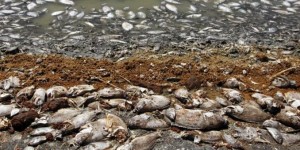
Scientists reluctant to stop ‘red tide’ algae bloom
Beachgoers could soon be seeing red off the Florida coast. A microscopic algae is growing out of control in the Gulf Coast. Although it can be toxic to marine life, some scientists are unsure if stopping it is the best option.
“Scientists say a huge bloom of red tide is coming to Florida’s west coast and this could be the biggest bloom the state has seen in more than ten years. They say it has already killed thousands of fish out in the gulf and moving Southwest.”
Karenia brevis, or K. brevis for short, is the blood red algae to blame. On Monday, the Florida Fish and Wildlife Conservation Commission said the bloom was a whopping 90 miles long, 60 miles wide — and growing. It sits just 20 miles off the coast of western Florida. Researchers monitoring the bloom say it was around 80 miles wide a few weeks ago.
This event is often called the “Florida Red Tide” and occurs when the K. brevis algae begins to multiply rapidly. The algae releases toxins into the ocean which are harmful to marine life.
The commission reports its hotline has already received reports of thousands of dead reef fish. While it’s not deadly to humans, the toxins could become an airborne threat and move on shore where they can irritate those living with asthma or emphysema. Despite its current size, several media outlets pointed out it’s the not the biggest bloom ever recorded, but it is the largest since 2005.
 In fact, Florida’s Red Tide is not an unusual event and is well-documented by researchers. That said, a Wildlife Conservation commissioner told WFTS the tide reminds him of a destructive bloom in 2005 that reached Florida’s shores.
In fact, Florida’s Red Tide is not an unusual event and is well-documented by researchers. That said, a Wildlife Conservation commissioner told WFTS the tide reminds him of a destructive bloom in 2005 that reached Florida’s shores.
“In 2005 we also had a hipoxic event near the same area, and it killed a lot of reefs and reef fish. So we’re kind of nervous seeing that again.”
These algae blooms are also naturally occurring. The Orlando Sentinel reports this puts scientists in a tough position – they have little control over the algae and some don’t think it should be disturbed. Hayley Rutger, a spokeswoman with Mote Marine Laboratory and Aquarium explains…
“Because they are naturally occurring, if you try to alter them you could affect other marine life in ways you hadn’t bargained for. Trying to affect the bloom in some way is a lot more complicated than you’d want it to be.”
NBC reports last Thursday, researchers predicted the algae bloom could reach Florida shores within the next two weeks.

